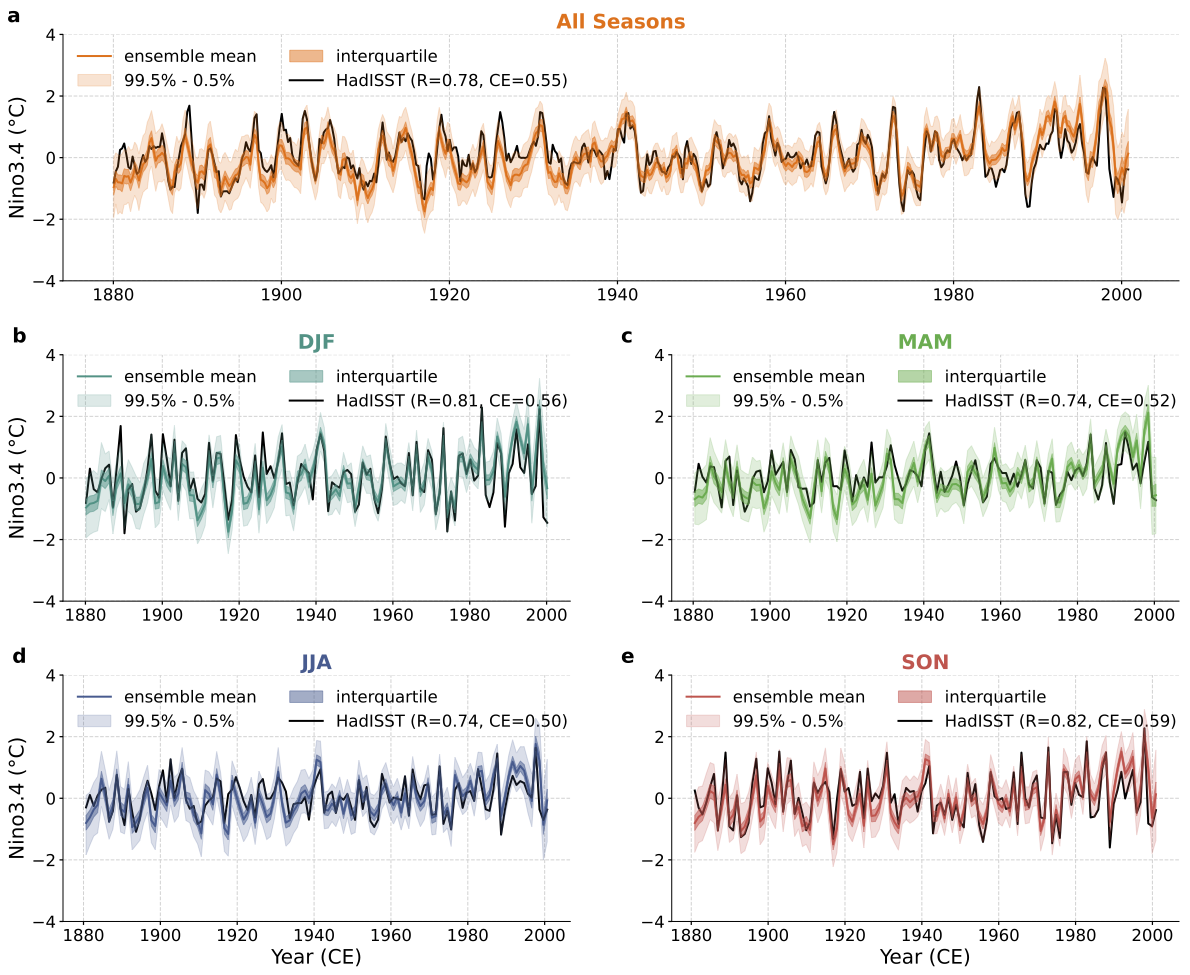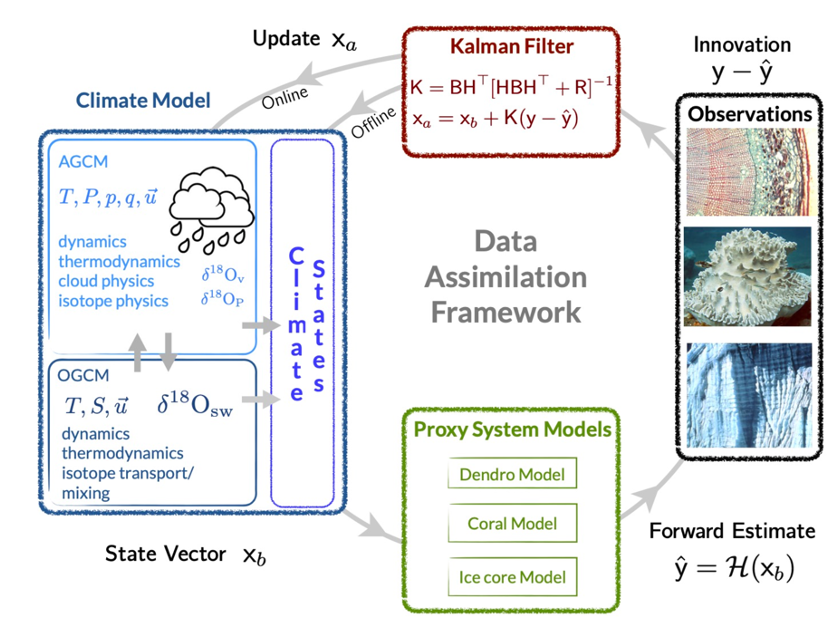Zilu Meng (孟子路)
About Me

Hi, I am Zilu Meng, a Ph.D. Candidate at the University of Washington, working under the guidance of Prof. Gregory J. Hakim and Prof. Eric J. Steig. Prior to this, I earned my B.S. with honors in Atmospheric Sciences from Nanjing University of Information Science and Technology (NUIST) (Nanjing Institute of Meteorology), where I conducted research on tropical dynamics with Prof. Tim Li.
My research interests include data assimilation, climate dynamics, paleoclimate, and machine learning. Currently, my work focuses on paleoclimate data assimilation and investigating climate dynamics over the last millennium. I develop statistical approaches and physical models to better understand past climate variability and dynamics, with the ultimate goal of improving the accuracy of weather and climate predictions. In my free time, I enjoy playing video games, reading, and hiking.
My Curriculum Vitae can be found here.
Research Highlights
AMIP-like experiments on Deep learning based AGCM
Using Deep Learning based AGCMs (Neural GCM, DLESyM, ACE2), we conducted AMIP-like experiments spanning 1890-2020. We investigate two key questions: (1) Can these models simulate atmospheric conditions outside their training range? (2) How well do these models capture climate sensitivity and physical consistency compared to the real world?
Paleoclimate Data Assimilation
Paleoclimate data assimilation is a powerful technique for reconstructing past climate states before the instrumental era. Instrumental records are relatively short and heavily influenced by anthropogenic forcing, limiting our understanding of natural climate variability. Paleoclimate proxies (e.g., tree rings, ice cores, corals) provide valuable indirect information about past conditions. By integrating these proxies with climate models through data assimilation, we can generate comprehensive reconstructions of past climate fields (temperature, precipitation, etc.) and study phenomena like ENSO, PDO, and AMO over longer timescales.
I am currently developing the first seasonal reanalysis dataset covering the last millennium using an "online" or "cycling" data assimilation approach. This dataset will provide gridded climate fields, enabling detailed studies of past climate variability and change. For instance, the comparison (shown right) of the Nino3.4 Index from our reanalysis with the HadISST dataset highlights the potential to accurately capture ENSO behavior over the millennium. This allows for comparisons between past and present climate dynamics.
A manuscript detailing this work has been published in the Journal of Climate (Meng et al., 2025, [PDF]).


Data
LMR Seasonal - Last Millennium Reanalysis with Seasonal Resolution
Dataset: LMR Seasonal Data Portal
"Online" data assimilation (DA) is used to generate a seasonal-resolution reanalysis dataset over the last millennium by combining forecasts from an ocean–atmosphere–sea-ice coupled linear inverse model with climate proxy records. Instrumental verification reveals that this reconstruction achieves the highest correlation skill, while using fewer proxies, in surface temperature reconstructions compared to other paleo-DA products, particularly during boreal winter when proxy data are scarce. Reconstructed ocean and sea-ice variables also have high correlation with instrumental and satellite datasets. Verification against independent proxy records shows that reconstruction skill is robust throughout the last millennium. Analysis of the results reveals that the method effectively captures the seasonal evolution and amplitude of El Niño events, seasonal temperature trends that are consistent with orbital forcing over the last millennium, and polar-amplified cooling in the transition from the Medieval Climate Anomaly to the Little Ice Age.
Key Features:
- Seasonal resolution paleoclimate reanalysis spanning the last millennium (850-2000 CE)
- Coupled ocean-atmosphere-sea ice reconstruction using online data assimilation
- High correlation skill with instrumental data, especially during data-sparse winter months
- Captures seasonal evolution and amplitude of ENSO events
- Consistent with orbital forcing patterns over the millennium
- Documents polar-amplified cooling during Medieval Climate Anomaly to Little Ice Age transition
Related Publication: Meng et al. (2025), Journal of Climate
Publications
- Hua, Z., Karamperidou, C., Meng, Z. (2025). Extratropical Atmospheric Circulation Response to ENSO in Deep Learning Pacific Pacemaker Experiments. arXiv:2511.20899
- Meng, Z. et al. (2025). Large-Ensemble Simulations Reveal Links Between Atmospheric Blocking and Sea Surface Temperature Variability
- Meng, Z., Hakim, G. J., Yang, W., & Vecchi, G. A. (2025). Deep Learning Atmospheric Models Reliably Simulate Out-of-Sample Land Heat and Cold Wave Frequencies. arXiv:2507.03176
- Meng, Z., & Polvani, L. M. (2025). No evidence for significant warming or cooling in Eurasian winter response to major volcanic eruptions over the last millennium.
- Meng, Z., Hakim, G. J., & Steig, E. J. (2024). Coupled Seasonal Data Assimilation of Sea Ice, Ocean, and Atmospheric Dynamics over the Last Millennium. Journal of Climate, 38, 7229–7247. https://doi.org/10.1175/JCLI-D-25-0048.1. [PDF], [Supplementary Material], [Data], [Code], [Bilibili Video (Chinese)].
- Meng, Z., & Hakim, G. J. (2024). Reconstructing the Tropical Pacific Upper Ocean using Online Data Assimilation with a Deep Learning model. Journal of Advances in Modeling Earth Systems, 16, e2024MS004422. https://doi.org/10.1029/2024MS004422. [Code], [Poster].
- Meng, Z., & Li, T. (2024). Why is the Pacific meridional mode most pronounced in boreal spring? Climate Dynamics, 62(1), 459–471. https://doi.org/10.1007/s00382-023-06914-4. [Code], [Thesis (Chinese)], [Sacpy Code], [Sacpy Poster].
- Zhu, F., Emile-Geay, J., Anchukaitis, K. J., McKay, N. P., Stevenson, S., & Meng, Z. (2023). A pseudoproxy emulation of the PAGES 2k database using a hierarchy of proxy system models. Scientific Data, 10, 624. https://doi.org/10.1038/s41597-023-02489-1. [CFR Code].
- Meng, Z., Hu, Z., Ai, Z., Zhang, Y., & Shan, K. (2021). Research on Planar Double Compound Pendulum Based on RK-8 Algorithm. Journal on Big Data, 3, 11–20. https://doi.org/10.32604/jbd.2021.015208, [Sacpy Code].
Education
- Ph.D. in Climate and Atmospheric Sciences
- University of Washington, Seattle, WA, USA (2023 - Present)
- Advisors: Prof. Gregory J. Hakim & Prof. Eric J. Steig
- Research Interests: Data assimilation, Machine learning, Climate dynamics, Paleoclimate
- B.S. in Atmospheric Science (with Honors)
- Nanjing University of Information Science and Technology (NUIST,or Nanjing Institute of Meteorology), Nanjing, China (2019 - 2023)
- Advisor: Prof. Tim Li
- Core Courses: Atmospheric (Fluid) Dynamics, Atmospheric Physics, Synoptic Meteorology
- GPA: 95/100 (Ranked 1st/50 in honors class)
- Thesis: Why is the Pacific meridional mode most pronounced in boreal spring? [Paper, Thesis (Chinese)]
Projects
- Last Millennium Seasonal Reanalysis: Developed a seasonal reanalysis dataset for the last millennium using online data assimilation. [Poster, Code]
- Deep Learning for Tropical Pacific Reconstruction: Developed a deep learning model coupled with online data assimilation to reconstruct tropical climate fields. [Paper, Poster, GitHub]
- AMIP experiments on Deep Learning GCMs: Conducted AMIP experiments on various deep learning GCMs to study climate sensitivity and long-term simulation capabilities.
- Sacpy: Built an efficient and user-friendly Python module for Statistical Analysis of Climate data. Widely used in the community. [Docs & GitHub, Poster]
- CFR Framework: Contributed to developing CFR, a universal framework for climate field reconstruction. [GitHub]
- Deep Learning for ENSO Prediction: Used deep learning (CNNs) and Grad-CAM to study predictability and precursors of El Niño/La Niña events. [Zhihu Article, GitHub]
- Prof. John Mike Wallace's Website: Assisted Prof. J. M. Wallace in building his personal academic website. [Website]
Conference Presentations & Talks
-
University of Hawaii at Manoa ATMO Seminar, Honolulu, HI, USA, Nov 2025. (Invited Talk)
Coupled Seasonal Data Assimilation over the Last Millennium -
Graduate Climate Conference (GCC), Boston, MA, USA, Oct 2025. (Poster)
Sacpy: A Python Module for Statistical Analysis of Climate Data -
PCC Summer Institute, Seattle, WA, USA, Sep 2025. (Poster)
Last Millennium Seasonal Reanalysis. [Poster] -
Climate Dynamics Seminar, Nanjing Normal University, Nanjing, China, Mar 2025. (Invited Talk)
Uncovering Insights from the Last Millennium Using Coupled Seasonal Data Assimilation of Sea Ice, Ocean, and Atmospheric Dynamics. [Slides] -
Data Assimilation Seminar, Nanjing University, Nanjing, China, Mar 2025. (Invited Talk)
Ocean, Atmosphere, and Sea Ice Data Assimilation for the Last Millennium. -
Climate Dynamics Seminar, University of Washington, Seattle, WA, USA, Feb 2025.
Uncovering Insights from the Last Millennium Using Coupled Seasonal Data Assimilation... -
AGU Fall Meeting, Washington, D.C., USA, Dec 2024. (Oral Presentation)
Reconstructing the Tropical Pacific Upper Ocean using Online Data Assimilation with a Deep Learning model. [Paper] -
Graduate Climate Conference (GCC), Seattle, WA, USA, Oct 2024. (Poster)
Last Millennium Seasonal Reanalysis. [Poster] -
Nanjing Data Assimilation Workshop, Nanjing, China, June 2024. (Poster)
Deep Learning for Tropical Pacific Reconstruction. [Poster, GitHub] -
PCC Summer Institute Talk, UW, Seattle, WA, USA, May 2024.
Deep Learning for Data Assimilation. -
AGU Fall Meeting, San Francisco, CA, USA, Dec 2023. (Poster)
Sacpy: Python Package for Statistical Analysis of Climate. [Poster, GitHub]
Peer Review Service
- Earth System Science Data (3)
- PLOS ONE (3)
- Climate Dynamics (1)
- JGR: Machine Learning and Computation (1)
- JGR Atmosphere (1)
- Atmosphere (1)
- Radio Science (1)
- Frontiers in Earth Science (1)
Summary of completed reviews.